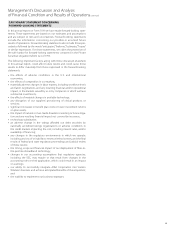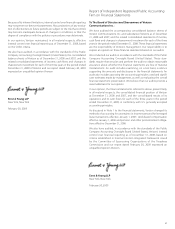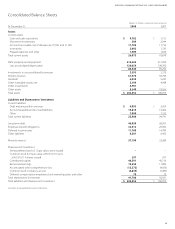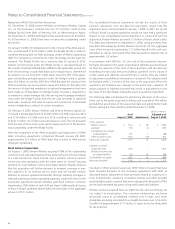Verizon Wireless 2008 Annual Report Download - page 45
Download and view the complete annual report
Please find page 45 of the 2008 Verizon Wireless annual report below. You can navigate through the pages in the report by either clicking on the pages listed below, or by using the keyword search tool below to find specific information within the annual report.
Notes to Consolidated Financial Statements continued
43
Discontinued Operations, Assets Held for Sale, and Sales of
Businesses and Investments
We classify as discontinued operations for all periods presented any
component of our business that we hold for sale or disposal that has
operations and cash flows that are clearly distinguishable operationally
and for financial reporting purposes from the rest of Verizon. For those
components, Verizon has no significant continuing involvement after dis-
posal and their operations and cash flows are eliminated from Verizon’s
ongoing operations. Sales of significant components of our business
not classified as discontinued operations are reported as either Equity in
earnings of unconsolidated businesses or Other income and (expense),
net in our consolidated statements of income.
Maintenance and Repairs
We charge the cost of maintenance and repairs, including the cost of
replacing minor items not constituting substantial betterments, princi-
pally to Cost of services and sales as these costs are incurred.
Advertising Costs
Advertising costs for advertising products and services as well as other
promotional and sponsorship costs are charged to Selling, general and
administrative expense in the periods in which they are incurred (see
Note 19).
Earnings Per Common Share
Basic earnings per common share are based on the weighted-average
number of shares outstanding during the period. Diluted earnings per
common share include the dilutive effect of shares issuable under our
stock-based compensation plans, an exchangeable equity interest and
zero-coupon convertible notes (see Note 13). As of December 31, 2006,
the exchangeable equity interest and zero-coupon convertible notes
were no longer outstanding.
Cash and Cash Equivalents
We consider all highly liquid investments with a maturity of 90 days or
less when purchased to be cash equivalents. Cash equivalents are stated
at cost, which approximates market value and include amounts held
in money market funds. Prior to the close of the acquisition of Alltel
Corporation (Alltel) we redeemed approximately $8.9 billion of these
money market funds (see Note 2).
Short-Term Investments
Our short-term investments, which are stated at fair value, consist pri-
marily of money market funds, a portion of which is held in trust to pay
for certain employee benefits.
Marketable Securities
Marketable securities are included in the accompanying consolidated
balance sheets in Short-term investments, Investments in uncon-
solidated businesses or Other assets. We continually evaluate our
investments in marketable securities for impairment due to declines
in market value considered to be other-than-temporary. That evalua-
tion includes, in addition to persistent, declining stock prices, general
economic and company-specific evaluations. In the event of a determi-
nation that a decline in market value is other-than-temporary, a charge
to earnings is recorded for the loss, and a new cost basis in the invest-
ment is established.
Inventories
Inventory consists of wireless and wireline equipment held for sale,
which is carried at the lower of cost (determined principally on either
an average cost or first-in, first-out basis) or market. We also include in
inventory new and reusable supplies and network equipment of our
local telephone operations, which are stated principally at average
original cost, except that specific costs are used in the case of large indi-
vidual items.
Plant and Depreciation
We record plant, property and equipment at cost. Our local telephone
operations’ depreciation expense is principally based on the composite
group remaining life method and straight-line composite rates. This
method provides for the recognition of the cost of the remaining net
investment in local telephone plant, less anticipated net salvage value,
over the remaining asset lives. This method requires the periodic revi-
sion of depreciation rates.
Plant, property and equipment of other wireline and wireless operations
are generally depreciated on a straight-line basis.
The asset lives used by our operations are presented in the following
table:
Average Useful Lives (in years)
Buildings 8 – 45
Central oce equipment 3 – 11
Other network equipment 3 – 15
Outside communications plant
Copper cable 13 – 18
Fiber cable (including undersea cable) 11 – 25
Poles, conduit and other 30 – 50
Furniture, vehicles and other 1 – 20
When we replace, retire or otherwise dispose of depreciable plant used
in our local telephone network, we deduct the carrying amount of such
plant from the respective accounts and charge it to accumulated depre-
ciation. When the depreciable assets of our other wireline and wireless
operations are retired or otherwise disposed of, the related cost and
accumulated depreciation are deducted from the plant accounts, and
any gains or losses on disposition are recognized in income.
We capitalize network software purchased or developed along with
related plant assets. We also capitalize interest associated with the acqui-
sition or construction of network-related assets. Capitalized interest is
reported as part of the cost of the network-related assets and as a reduc-
tion in interest expense.
In connection with our ongoing review of the average useful lives of
plant, property and equipment, we determined, effective January 1,
2009 that the average useful lives of fiber cable would be increased to
25 years from 20 to 25 years and the average useful lives of copper cable
would be changed to 15 years from 13 to 18 years. These changes are not
expected to have a significant impact on our depreciation expense for
2009. Effective January 1, 2008 the average useful lives of fiber cable was
increased from 20 years to 20 to 25 years. This change did not result in
a significant impact to depreciation expense for 2008. Effective January
1, 2007, the average useful lives of certain of the circuit equipment was
lengthened from 8 years to 9 years based on subsequent modifications to
our fiber optic cable deployment plan. The average useful lives of certain
buildings at Wireline was also increased from 42 years to 45 years. The
reduction in depreciation resulting from these adjustments in 2007 was
partially offset by increased depreciation resulting from the shortening
of the lives of various types of wireless plant, property and equipment.
While the timing and extent of current deployment plans are subject to
modification, we believe the current estimates of impacted asset lives
are reasonable and subject to ongoing analysis.
























